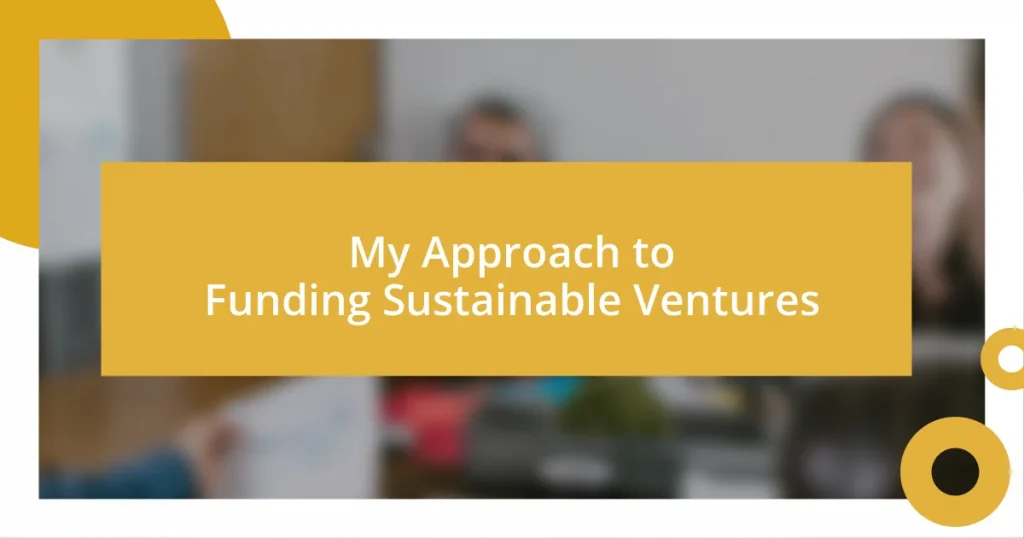Key takeaways:
- Sustainable venture funding prioritizes environmental and social impacts alongside financial returns, emphasizing the importance of alignment with values.
- Key principles of sustainable finance include environmental responsibility, social equity, and strong governance, which guide investment decisions for holistic growth.
- Building partnerships and effective communication enhance impact, while measuring success incorporates social and environmental assessments alongside traditional metrics.

Understanding sustainable venture funding
Sustainable venture funding is about more than just financial backing; it’s a commitment to creating positive environmental and social impacts. I remember my initial encounter with a startup focused on renewable energy. The passion of its founders was so contagious that it made me think: what if our investments could reflect our values? It’s a challenge to find funding that aligns with sustainable practices, but it’s also incredibly rewarding.
As I dug deeper into the realm of sustainable funding, I discovered various models, like impact investing. This approach evaluates potential investments based on their social and environmental effects alongside financial returns. I’ve often pondered how many people overlook these opportunities. I’ve seen firsthand how aligning investment strategies with sustainability goals can yield unexpected benefits, opening doors to new markets and fostering trust among consumers.
Navigating this landscape can be complex. However, I’ve learned that collaboration with like-minded investors and organizations is key. I often ask myself: how can we pool our resources to support ventures that not only seek profit but also aim to heal our planet? Each partnership can amplify our impact and help foster a community dedicated to sustainable change.

Key principles of sustainable finance
The core of sustainable finance revolves around creating value that transcends mere profit. From my experience, I’ve come to appreciate three key principles: environmental responsibility, social equity, and robust governance structures. These principles underpin every investment decision I make and guide me toward ventures that not only promise financial returns but also contribute positively to society and the planet. I remember a project where we prioritized sustainability metrics over traditional KPIs; seeing how that shift attracted investors who genuinely cared about impact made me believe even more in this approach.
- Environmental responsibility: This principle emphasizes minimizing carbon footprints and preserving biodiversity.
- Social equity: Investments should foster inclusion and equality, benefitting all community members.
- Strong governance: Ethical management and transparency are essential to build trust and ensure accountability.
Sustainable finance is built on these pillars, and I often reflect on how each decision can ripple through communities. For instance, supporting a local business initiative that provides job training not only strengthens the economy but also empowers individuals. This interconnectedness is what makes my journey in sustainable funding so fulfilling. Each venture isn’t just a financial transaction; it’s a chance to promote holistic growth and positive change.

Identifying funding sources for sustainability
Identifying funding sources for sustainability involves a nuanced approach. I remember my early days of searching for investors who shared my vision for a greener future. It felt like a treasure hunt, sifting through possibilities to find those who truly prioritized sustainability. Eventually, I learned that looking beyond traditional funding avenues opened up exciting opportunities. For instance, I connected with local environmental organizations that were eager to support eco-friendly ventures through grants and collaborative programs.
As I navigated my journey, I discovered several key funding sources. Crowdfunding platforms became a game changer, allowing passionate entrepreneurs to raise money directly from individuals who believed in their cause. I recall backing a green technology startup via one such platform, and it was inspiring to see how many people were willing to invest in a cleaner future. Additionally, government grants and subsidies frequently target sustainable projects, offering financial incentives for innovations that benefit the environment.
To summarize my experience, I compiled a table comparing common funding sources for sustainability. This clarity supports better decision-making when exploring funding options.
| Funding Source | Description |
|---|---|
| Venture Capital | Investment from firms focused on startups that demonstrate high growth potential and sustainability. |
| Crowdfunding | Raising funds from a large number of people online, often for innovative projects that resonate with public values. |
| Grants | Non-repayable funds provided by governments or organizations specifically for sustainable initiatives. |

Developing a compelling business case
When developing a compelling business case, it’s crucial to weave together a narrative that resonates with potential investors. I recall crafting a proposal for a renewable energy project that highlighted not only the financial projections but also the community benefits—like job creation and reduced energy costs. This storytelling approach transformed a standard business case into a compelling vision that investors found hard to resist. Have you ever considered how a well-told story could shift perspectives on the viability of a venture?
A solid business case goes beyond just numbers; it should also detail the environmental and social impact of the venture. One project I worked on focused on urban green spaces, and we made sure to quantify the potential improvements in air quality and community well-being. By providing data and testimonials, we painted a picture of a healthier future, making the case doubly persuasive. Isn’t it fascinating how connecting data to human emotions can enhance our arguments for sustainable initiatives?
In my experience, building a compelling business case means anticipating the questions that potential funders might have. For example, during a pitch for eco-friendly building materials, I prepared for concerns about scalability and market demand by presenting case studies from similar successful ventures. This proactive approach not only addressed doubts but also instilled confidence. Don’t you think it’s essential to prepare thoroughly to transform skepticism into excitement for your project?

Strategies for attracting investors
Attracting investors is often about creating connections and showcasing shared values. I can remember one memorable pitch where I focused not just on the financial projections, but on the inspiring stories of communities impacted by our sustainable initiatives. By painting vivid pictures of what our venture could achieve, I aimed to resonate emotionally with potential investors, encouraging them to see their role as partners in a greater mission. Isn’t it amazing how stories can turn numbers into meaningful narratives?
Networking plays a crucial role in the journey to attract investors. I’ve found that attending industry conferences and sustainability-focused events offers not only exposure but also invaluable connections. It was at a recent eco-innovation summit that I met an investor who was genuinely interested in clean technology. We didn’t just exchange business cards; we shared ideas, passions, and visions for a sustainable future. How often do you think genuine conversations can lead to fruitful partnerships?
Lastly, carefully curating a pitch deck that combines visuals with concise information can work wonders. My experience tells me that investors are often inundated with proposals, so standing out is essential. In one instance, incorporating infographics related to environmental impact helped convey complex data in an engaging way. It’s a simple yet effective strategy—what better way to grab attention than to present crucial information in a visually compelling format?

Building partnerships for sustainable impact
Building partnerships for sustainable impact starts with identifying common goals. I remember collaborating with a local non-profit that shared our vision for a circular economy. It was incredible to see how our shared commitment to sustainability not only fostered innovative ideas but also created a sense of community among our teams. How often do we overlook the power of aligning our missions with others?
Trust is another critical element in nurturing these partnerships. During a project focused on renewable water resources, I had the privilege of working closely with an academic institution. Their research lent credibility to our venture, and in return, we provided them with real-world applications for their findings. This reciprocal relationship built a foundation of trust and mutual respect, emphasizing how partnerships can amplify impact. Have you ever experienced the magic of collaboration where both parties grow together?
Finally, effective communication is key to sustaining partnerships. I learned this firsthand when I facilitated monthly meetings with our partners, ensuring everyone felt heard and valued. It was during these discussions that we could align our strategies and celebrate milestones, fostering a stronger bond and commitment to our shared objectives. Isn’t it fascinating how open dialogue can transform a partnership into a thriving ecosystem for change?

Measuring success in sustainable ventures
Measuring success in sustainable ventures goes beyond traditional financial metrics. In my experience, I’ve found that incorporating social and environmental impact assessments can truly enrich our understanding of a venture’s performance. For instance, a project aimed at reducing plastic waste not only tracked revenue but also measured the amount of plastic recycled and its effects on local ecosystems. Isn’t it remarkable how a broader perspective can reveal a venture’s deeper legacy?
I’ve also learned that stakeholder feedback is invaluable when it comes to measurement. While working on a renewable energy initiative, we regularly surveyed community members about their experiences and expectations. Their insights not only guided our decision-making but also highlighted areas where we could improve our services. Do you see how engaging with those affected by our ventures can provide a clearer picture of our success?
Lastly, I’ve come to appreciate the role of storytelling in measurement. In a recent project, we collaborated with beneficiaries to share their personal journeys and the positive changes brought about by our initiatives. These narratives captured the essence of our impact far better than charts or graphs ever could. Have you considered how powerful stories can illuminate the true value of your sustainable ventures?















